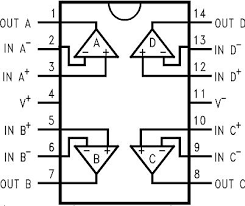Zeebit
0
- Joined
- Aug 27, 2012
- Messages
- 1,110
- Points
- 0
Hey guys.
I need help figuring out the pinout of an LM324 IC. I am still a bit of a noob with electronics. I will be using this chip for an audio mixer and it will be powered by SMPS from a pc.

Is it correct that I hook up pin 4 to a positive rail and pin 11 to the PSU ground?
I need help figuring out the pinout of an LM324 IC. I am still a bit of a noob with electronics. I will be using this chip for an audio mixer and it will be powered by SMPS from a pc.
Is it correct that I hook up pin 4 to a positive rail and pin 11 to the PSU ground?



